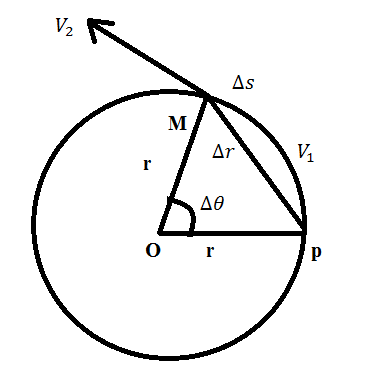
Define centripetal acceleration. Drive expression for centripetal acceleration of a particle moving with uniform speed v along a circular path of radius. Give the direction of the acceleration.
Answer
507.1k+ views
Hint: Centripetal acceleration occurs due to centripetal force. It is also called radial acceleration. Centripetal force tends to move a body in a circular path. It acts towards the centre of the body in which a body is traversing.
Complete step-by-step answer:
Centripetal Acceleration is the acceleration which acts towards the centre of the body. It is the property of a body. It is the property of a body performing circular motion.
It arises due to centripetal force which acts constantly towards the centre of the circle. It is perpendicular to the velocity. It is due to that change in velocity (in terms of direction such acceleration appears)
\[ac=\dfrac{\vartriangle V}{\vartriangle t}=\dfrac{{{V}^{2}}}{R}\]
V = velocity of particle
R = Radius
Suppose a body moving \[{{V}_{1}}\] with velocity transverses velocity changes to \[{{V}_{2}}\] .(In terms of direction) the net change in velocity generates the acceleration.

\[\vartriangle V={{V}_{2}}-{{V}_{1}}\]
\[\vartriangle s\to \]Change of radius of the length PM
\[\vartriangle r\to \]Displacement or arc length PM
As \[ac=\dfrac{\vartriangle V}{\vartriangle t}\] (the acceleration is towards center) \[\vartriangle Q\]as is small and \[\vartriangle s\approx \vartriangle r\]
.Now for magnitude,
The triangles PTR and OPM are similar above magnitude wise \[{{\text{V}}_{\text{1}}}\text{=}{{\text{V}}_{\text{2}}}\]so they form a 2 isosceles triangles.
So using property of similar triangles,
\[\frac{\vartriangle V}{V}=\dfrac{\vartriangle s}{r}\] …… 1
Centripetal acceleration is \[\dfrac{\vartriangle V}{\vartriangle t}\]
Multiply and divide by
\[\dfrac{\vartriangle \text{V}}{\vartriangle t}=\dfrac{\vartriangle s}{\vartriangle t}\frac{V}{r}\]
\[\dfrac{\vartriangle \text{V}}{\vartriangle t}=\] Acceleration (centripetal)
And that \[\dfrac{\vartriangle s}{\vartriangle t}=\] velocity (V) = linear / tangential velocity / speed
So
\[\text{ac=}\dfrac{{{\text{V}}^{\text{2}}}}{\text{R}}\] …. 2
So we have linear or that ac is perpendicular to linear or tangential velocity
Note:
Centrifugal force: It is the reaction centripetal force and acts away from the centre. Its magnitude is equal to that of centripetal force.
Complete step-by-step answer:
Centripetal Acceleration is the acceleration which acts towards the centre of the body. It is the property of a body. It is the property of a body performing circular motion.
It arises due to centripetal force which acts constantly towards the centre of the circle. It is perpendicular to the velocity. It is due to that change in velocity (in terms of direction such acceleration appears)
\[ac=\dfrac{\vartriangle V}{\vartriangle t}=\dfrac{{{V}^{2}}}{R}\]
V = velocity of particle
R = Radius
Suppose a body moving \[{{V}_{1}}\] with velocity transverses velocity changes to \[{{V}_{2}}\] .(In terms of direction) the net change in velocity generates the acceleration.

\[\vartriangle V={{V}_{2}}-{{V}_{1}}\]
\[\vartriangle s\to \]Change of radius of the length PM
\[\vartriangle r\to \]Displacement or arc length PM
As \[ac=\dfrac{\vartriangle V}{\vartriangle t}\] (the acceleration is towards center) \[\vartriangle Q\]as is small and \[\vartriangle s\approx \vartriangle r\]
.Now for magnitude,
The triangles PTR and OPM are similar above magnitude wise \[{{\text{V}}_{\text{1}}}\text{=}{{\text{V}}_{\text{2}}}\]so they form a 2 isosceles triangles.
So using property of similar triangles,
\[\frac{\vartriangle V}{V}=\dfrac{\vartriangle s}{r}\] …… 1
Centripetal acceleration is \[\dfrac{\vartriangle V}{\vartriangle t}\]
Multiply and divide by
\[\dfrac{\vartriangle \text{V}}{\vartriangle t}=\dfrac{\vartriangle s}{\vartriangle t}\frac{V}{r}\]
\[\dfrac{\vartriangle \text{V}}{\vartriangle t}=\] Acceleration (centripetal)
And that \[\dfrac{\vartriangle s}{\vartriangle t}=\] velocity (V) = linear / tangential velocity / speed
So
\[\text{ac=}\dfrac{{{\text{V}}^{\text{2}}}}{\text{R}}\] …. 2
So we have linear or that ac is perpendicular to linear or tangential velocity
Note:
Centrifugal force: It is the reaction centripetal force and acts away from the centre. Its magnitude is equal to that of centripetal force.
Recently Updated Pages
Master Class 12 Business Studies: Engaging Questions & Answers for Success

Master Class 12 Economics: Engaging Questions & Answers for Success

Master Class 12 English: Engaging Questions & Answers for Success

Master Class 12 Maths: Engaging Questions & Answers for Success

Master Class 12 Social Science: Engaging Questions & Answers for Success

Master Class 12 Chemistry: Engaging Questions & Answers for Success

Trending doubts
What is meant by exothermic and endothermic reactions class 11 chemistry CBSE

Which animal has three hearts class 11 biology CBSE

10 examples of friction in our daily life

One Metric ton is equal to kg A 10000 B 1000 C 100 class 11 physics CBSE

1 Quintal is equal to a 110 kg b 10 kg c 100kg d 1000 class 11 physics CBSE

Difference Between Prokaryotic Cells and Eukaryotic Cells




